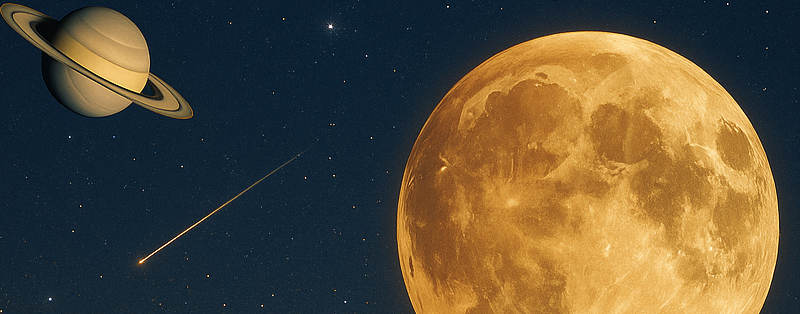
October Skywatch: Hunter’s Moon, Meteors & Moon Magic
October Skywatch: Hunter’s Moon, Meteors & Moon Magic
Hello, sky-watchers of Latin America and the Caribbean! October brings us the classic Hunter’s Moon, two meteor showers, and a handful of lovely Moon–planet and Moon–cluster meetups. Whether you’re stargazing from Santiago, Montevideo or San Juan, here’s your friendly, day-by-day guide to the month’s highlights. Clear skies!October 5: Saturn meets the Moon
As evening falls, look low in the southern sky for a waxing gibbous Moon drifting just north of golden Saturn. Binoculars or a small scope will frame the two beautifully—Saturn’s pale disk and rings beside the Moon’s bright limb make a lovely autumn pairing.October 7: Full “Hunter’s” Moon
October’s Full Moon rises at sunset on the 7th, bathing the night in soft, golden light. Often called the “Hunter’s Moon,” it’s perfect for an evening walk or a backyard stargazing party. With binoculars, look for the dark lunar “seas” contrasting with bright highlands, and catch the faint rays radiating from young craters.October 8–9: Peak of the Draconids Meteor Shower
On the nights of the 8th into the 9th, the Draconids meteors streak down from the head of Draco. Although not as prolific as some showers, they can surprise you with swift, earth-grazing meteors—watch from a dark site after midnight for the best show.October 9: Moon meets the Pleiades (M45)
That same evening, a waning gibbous Moon slides just above the misty Pleiades cluster in Taurus. Through binoculars, enjoy the contrast of the Moon’s pale curve against the cluster’s delicate spray of blue-white stars.October 13: Last Quarter Moon
By the 13th, the Moon has waned to its Last Quarter phase, rising around midnight with its left half illuminated. This soft side-lighting highlights valleys, rilles and crater walls—ideal for late-night lunar exploration.October 13: Jupiter meets the Moon
Also, before dawn on the 13th, turn east to see that half-lit Moon passing just south of brilliant Jupiter. Even the naked eye will pick them out, but binoculars will frame them in the same field for a charming morning sight.October 21: New Moon
The New Moon on the 21st disappears into the Sun’s glare, giving us the darkest skies of the month. It’s the perfect window for deep-sky observing—hunt galaxies, nebulae, and faint star clusters without moonlight washing them out.October 21–22: Peak of the Orionids Meteor Shower
Late on the 21st into the 22nd, the Orionids blaze across the sky, radiating from Orion’s club. With rates up to 20 meteors per hour under dark skies, it’s one of autumn’s best showers—watch after midnight for the fastest, brightest streaks.October 29: First Quarter Moon
Closing out the month, the Moon reaches First Quarter on the 29th, shining half-illuminated at sunset. This phase is perfect for tracing dramatic shadows along the terminator—grab binoculars for one last lunar tour before November’s skywatch begins.For full details—exact times, viewing tips, and more—please refer to Celestron’s 2025 Celestial Calendar and 2025 Moon Calendar.
Catch last month’s skywatch highlights here, and don’t miss November's upcoming cosmic wonders in our next post. Happy observing!.
